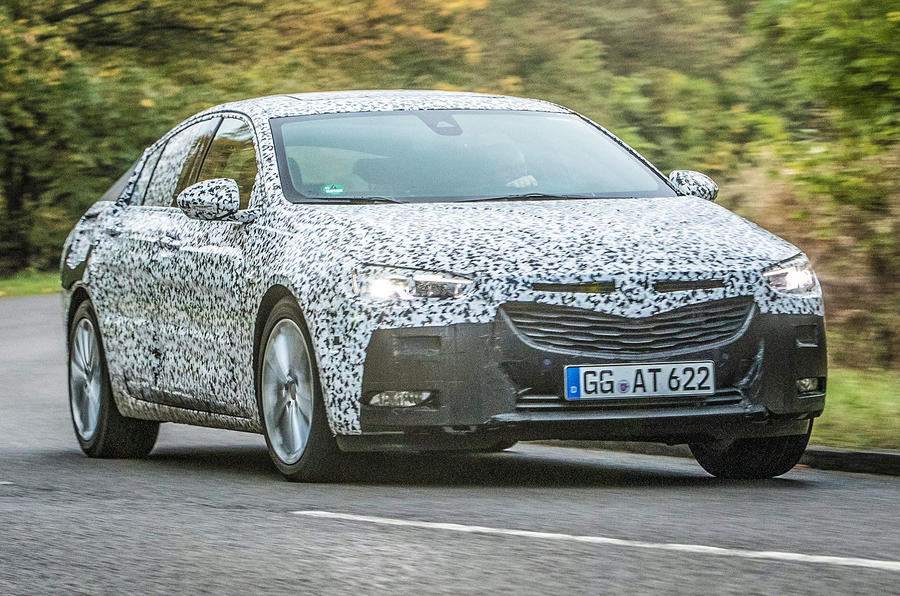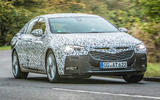What is it?
The big mainstream hatchback isn’t dead. In fact, the Vauxhall Insignia has always done rather well in the UK. The British buy twice as many of 'em as any other country, and the model is due for replacement next year.
This is an early drive of a late development example of the next-generation Insignia; a ‘validation prototype’, they call it, used by engineers to prove components and for management to sign them off at various steps along the way.
2017 Vauxhall Insignia Grand Sport officially revealed
It’s a funny old market segment, this one. Once it was called the D-segment and in it a Vauxhall Vectra went up against a Ford Mondeo and a Peugeot 407 and a Renault Laguna and you knew where you were. These days, though, the Insignia’s traditional class doesn’t just encompass what you’d once call compact executive cars, namely the BMW 3 Series, Audi A4 and Mercedes-Benz C-Class; no, it’s absolutely dominated by them. Across Europe the Opel/Vauxhall Insignia is only the third best-selling car among them, behind the 3 Series and C-Class but ahead of the A4.
So this time the Insignia’s tack has changed a bit. Vauxhall is pitching it as 'the smartest alternative to premium'. The original Insignia was a biggish car in the segment anyway but has grown again, to 4897mm long, up 55mm, with a wheelbase, of 2829mm, that’s up by 92mm. That has pushed its size well into Skoda Superb territory, and almost into Audi A6/Mercedes E-Class territory. As with the Superb, if you choose an Insignia, they say, you’ll get a lot more space for your money. Which, if you can’t compete on badge alone, is not a bad way to pitch it.
The Insignia – which we’ll see undisguised in December – is based on a new global General Motors platform, scalable like all good new platforms are. The architecture is called E2 and, as with the recent Astra, weight removal is at the core of its aims. The body-in-white, then, is 13%, or 59kg, lighter than that of the old car, and typically models are 150kg lighter than their predecessors like-for-like. There had already been quite a lot of engine downsizing during the old car’s life, so we’re not talking about going from a 2.2 to a 1.5-litre diesel here.
So far we’ve tried two versions, both disguised and both with covers all over the interior and its very much unfinished plastics, but both representative of how the cars will drive. One was a 1.5-litre, 163bhp turbocharged petrol with a six-speed manual gearbox and front-wheel drive. The other was a 2.0-litre, 247bhp turbocharged petrol, which as standard will come with an eight-speed automatic gearbox and four-wheel drive. Bit more of a rare groove, then, that one, unless you’re CID officer.




















Join the debate
Add your comment
"Tyres on the test car were
Utterly ridiculous that these are the smallest tyres. By the time cars like this are eight or ten years old, awaiting their fourth, fifth or six owner, the cost of a set of the 20-inch tyres which are increasingly typical (and other spares and maintenance of unnecessary complexity) will make them an untenable proposition for the people who would be interested in buying them, and cars will become scrap with many years of viable life left in them.
Longevity is the true environmental challenge facing car manufacturers, but instead they are wasting time fannying about with electric cars and autonomous cars which are entirely useless.
The only environmentally friendly option is to keep old cars going.
They're making all the right
* Petrols aren't being neglected behind diesels (Honda, Nissan, I'm looking at you here in particular). * The fastest car in the range is a petrol (ditto).
* Strong focus on weight reduction and more interior room. Too many fail at the latter in particular.
* "Rightsizing" is a good move as they understand that you can't just keep shrinking displacement - in real-world driving a small, highly strung engine with equal power to a larger engine will deliver worse fuel economy under sustained load because it has to work harder.
* AWD is a nice left-field feature for cars in this class.
* If that eight speed auto is the ZF8, it's an excellent choice
Because cars tend to be
Cars like the 3 Series simply don't have the same practicality. Smaller interior, smaller boot, no folding rear seats plus a lower overall spec.